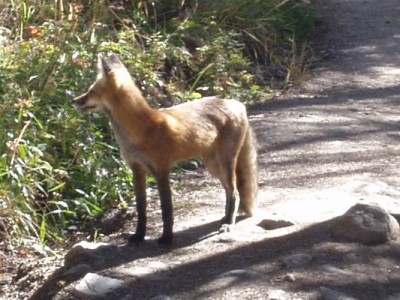A Wild Time in Rocky Mountain National Park
In celebration of our upcoming anniversary, my wife and I visited Rocky Mountain National Park this fall. We love camping and neither of us had seen this great example of accessible wildness. Our trip turned out to be much more educational and exciting than expected. We had close encounters with wildlife, a tour of a lodgepole forest ravaged by pine beetles and a brush with wildfire all while surrounded by a gorgeous landscape.
I usually sleep well when I'm camping. We have a good tent, comfy pads and warm sleeping bags, but sleep is difficult when the neighbors are carousing all night long. Our neighbors were several bull elk and their harems of cow elk. Who knew that elk were party animals? At least during rut season they are. If you've never heard an elk bugle, it is a distinctive sound that is well suited to interrupting a sound sleep. I think elk are a beautiful species and I understand their need to procreate, but I wonder if the reason they were first hunted was not for food but a good night's sleep.
We saw a bold Red Fox (Vulpes vulpes), a shy flock of Ptarmigan, soaring raptors and vultures, Mule Deer, and countless chipmunks and ground squirrels. With the wide range of ecosystems and great expanse of RMNP there are many species that live in the park. The Mountain Pine Beetle is one of the smallest critters living in the park, but it has left stark evidence of its presence.
The pine beetle feeds on the sap and phloem (inner bark) of multiple species of conifers including Lodgepole and Ponderosa pine. While a healthy tree can survive pine beetles, in times of drought and stress the beetles can overwhelm and kill many mature trees. Pine beetles are native to the Rocky Mountain forests but their populations have exploded in recent years due to a lack of cold winter weather that would limit their population. What this means is that the forests of Rocky Mountain National Park are in transition from dense stands of Lodgepole pine and Ponderosa to more varied ages and varieties of trees. Unfortunately the forest looks pretty rough with red swaths of standing dead trees while new seedlings are growing up underneath.
Another sign of the lack of consistently cold weather is the now-defunct Hidden Valley Ski Area. On the eastern side of RMNP is a remnant of skiing history and snowier winters. While the lifts have been removed there is a paved parking lot, picnic tables, a warming hut and bathrooms. If you are willing to hike up and 'earn your turns' you can ski, snowboard or sled in RMNP during the winter. Of course, you will need to bring your own equipment, healthy legs and lungs as the base elevation is 9,400 feet.
Rocky Mountain National Park held one more adventure for us - a wildfire. Living in the west, wildfire is perhaps the region's most familiar 'natural disaster'. It was still a surprise to learn that a wildfire had flared up during the windy afternoon a mile or so from our campsite. The next day we woke to a cold, still morning and watched as several firefighting crews rolled out to successfully battle the Onahu fire.
We never expected this much excitement from a national park. Maybe we just underestimated how wild the Rocky Mountains really are.
More Info:
Climate Change in Rocky Mountain National Park



Comments
RMNP
I'm glad you and your wife got to enjoy Rocky Mountain National Park at its noisiest! I recently drove through in the dead of night on the way back to Boulder -- we were driving up Trail Ridge Road and it seemed like we were driving straight at the full moon. 12,000 feet feels awfully close to that thing!